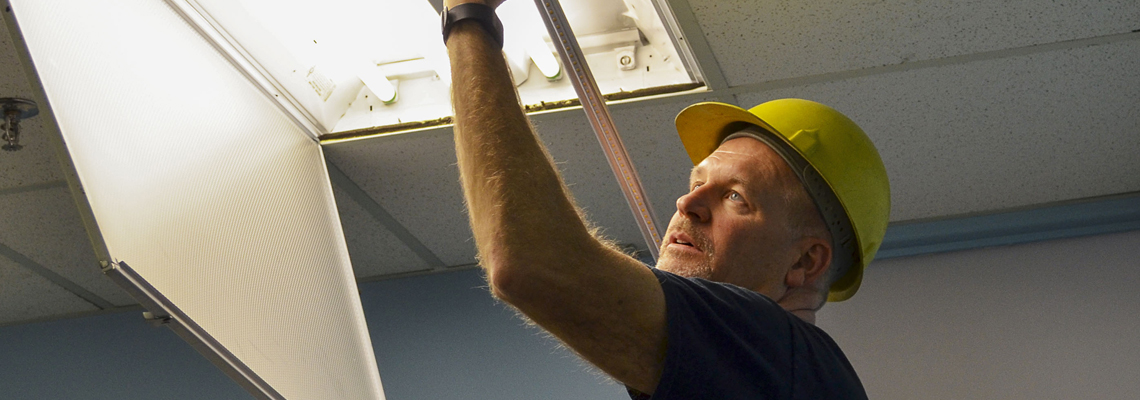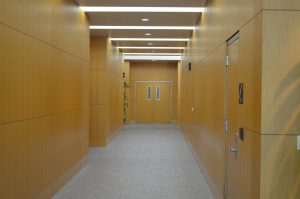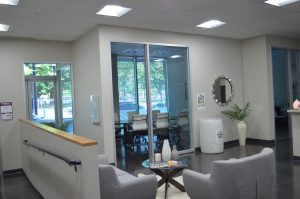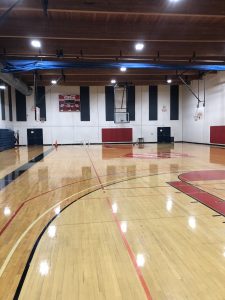LED Lighting: Do I Have to Replace Every Fixture?

Our LAMP program partner, Michael Reunert of Conserve Energy, answers your lighting questions in our new lighting blog series.
LED Lighting: Do I Have to Replace Every Fixture?
Customers often wonder if it is necessary to replace every existing fixture with new LED fixtures when replacing with LED lighting. The answer is no. There are three options for retrofitting with LED. These include; replacing existing lamps with LED lamps, Installing LED retrofit kits in existing fixtures, and replacing existing fixtures with new LED fixtures. Following is some information about each option:
LED Lamp replacement
If you have existing fixtures that are in good shape, the simplest, fastest, and lowest cost upgrade is to just remove the existing light bulbs or fluorescent tubes, “lamps” in industry parlance, and install new LED lamps. For small fixtures with screw-in lamps, this is definitely the way to go. LED screw-in lamps cost only a few dollars, come in a variety of light outputs (lumens), and color temperatures to meet most needs. Most LED screw-in lamps are dimmable, but you may need to change wall-mounted dimmers, as some older models are not compatible with LEDs.

LED tubes (Tubular LEDs or “TLEDs”) are available to replace T12, T8 and T5 fluorescent tubes. As with screw-in lamps, they are available in a range of lumen outputs and color temperatures. Fluorescent fixtures use ballasts to provide the correct voltage and current for the lamps. Some TLEDs are “ballast –compatible” with newer electronic ballasts so the retrofit can be as simple as just swapping lamps. However, if you are having this done professionally, most installers will bypass the ballast so that the TLEDs operate on line voltage. This assures there are no compatibility issues, such as flickering, and removes ballast as a point of failure to eliminate maintenance down the road. One consideration is that most TLEDs are not dimmable, so options for adding controls are limited.
Most existing higher wattage fixtures such as parking lot lighting and high bay fixtures in warehouses use High-Intensity Discharge (HID) lamps up to 1000W. LED lamps are available to replace these as well. Some larger LED lamps are sometimes referred to as “corn-cobs” because they have rows of yellow LED modules that look like kernels on an ear of corn. Similar to fluorescent fixtures, HID fixtures have a ballast that needs to be by-passed to install most LED lamps. Larger LED lamps are typically not dimmable. One downside is that the light distribution pattern from the fixture with an LED lamp installed may not match the existing fixture, since most high wattage fixtures manage the light output pattern with a reflector that was designed for the original HID lamp.
LED Retrofit Kits
For some fixtures, such as “troffers” and recessed downlights, LED retrofit kits are available. These kits replace the “guts” of the fixture but retain the original housing. When installed properly, a retrofit will often look like a brand new fixture. The optics are designed specifically for the LED modules that are included in the kit, so rest assured knowing that they will provide the proper light distribution. LED retrofit kits are generally dimmable and compatible with newer lighting control systems. Some are even available with built-in sensors on each fixture for maximum flexibility and energy savings.
The cost of a retrofit kit is more than a lamp retrofit, but less than a new fixture. Installation is generally pretty simple and can be accomplished without accessing the ceiling above the fixtures. Labor cost is often similar to the cost of a lamp replacement when the ballast is bypassed.

In older buildings, as long as wiring meets the local electrical code at the time of installation, the building owner is generally not obligated to make changes to update existing wiring when changes are made to the electrical code. However, if any changes are made to the wiring, such as installing a new fixture, then the wiring to that fixture must be brought up to current code. Depending on the state of the existing wiring, this can add significant expense. Since retrofit kits leave the original housing and junction boxes in place, they don’t require changes to the existing wiring and avoid this potential expense.
New LED fixtures:

For most existing fixtures, there is a new LED fixture available as a replacement. This excludes existing fixtures that are in poor condition, which may require new fixtures. New LED fixtures can significantly enhance the appearance of both the interior and exterior of a building and are designed specifically for the LED modules. This ensures that they will provide the proper light distribution. Most new LED fixtures are dimmable, compatible with newer lighting control systems and are available with built-in sensors on each fixture for maximum flexibility and energy savings. Some new LED fixtures even include the ability to change the color of the light to mimic daylight or set a specific mood in an office, classroom, etc.
Most exterior lighting retrofits use new fixtures. Area fixtures, such as parking lot pole fixtures, generally include specific lighting distribution to direct light where it is needed and minimize “light trespass” onto areas where it isn’t wanted, such as neighboring properties. Older fixtures achieved the desired light distribution through reflectors meant to direct the light from an omni-directional lamp in a specific pattern. They also often had shields added to prevent light trespass. Because LEDs produce directional light output, new LED exterior fixtures offer much better control of light distribution than older HID fixtures.
Which Option Should I Choose?
There is no single right answer to this question. LED Lamp retrofits will generally have the lowest up-front cost and might be the only option if the budget is limited. However, utility programs may offer higher incentives for retrofit kits or new fixtures compared to lamp retrofits, so it is important to check with the utility to determine the net cost after incentives have been received.
New fixtures and retrofit kits have a better appearance than retrofits of old fixtures and generally offer better lighting quality. Both new fixtures and retrofit kits give you the ability to add more advanced controls that will allow for more energy savings over time and can tie into a building management system. However, both parts and installation are more expensive. If you need to change the interior lighting design and layout, new fixtures are generally the best option. For exterior lighting, old fixtures may have weathered, have corroded housings and yellowed lenses that installation of an LED lamp won’t improve, so new fixtures are very common here as well.
Many projects, that cover a whole building upgrade, include a combination of all three options.
Want to find out which option(s) are best for your building?
Contact the Lloyd EcoDistrict/Conserve Energy team to discuss which option is best for your building.
If you end up doing a lighting retrofit through Lloyd EcoDistrict’s LAMP program, a portion of proceeds from LAMP supports Central City Concern, a social service and affordable housing provider. Your project will also support Lloyd EcoDistrict’s ongoing work to reduce greenhouse gas emissions.
Tags: Energy Efficiency, LAMP, LED Retrofit, LEDs
